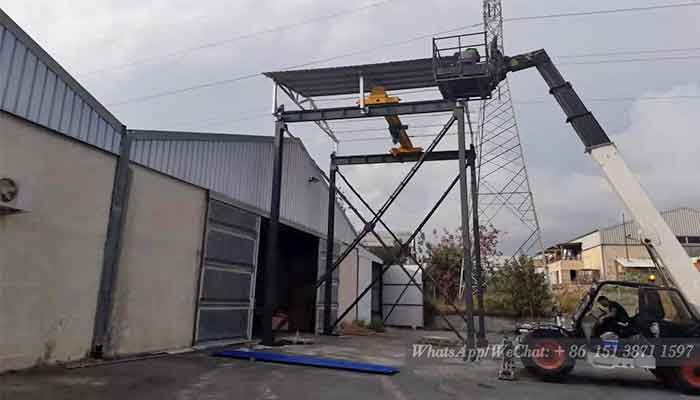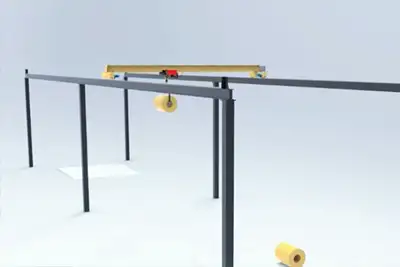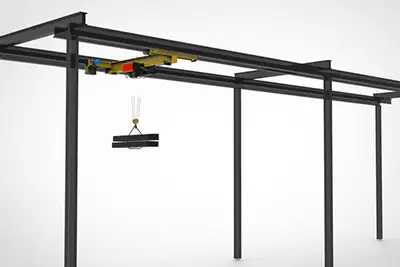
Free Standing Bridge Cranes: Avoid Costly Building Modifications
How Free Standing Bridge Cranes Help Buyers Avoid Costly Building Modifications? Discover how free standing overhead bridge cranes save buyers time and money by eliminating building modifications. Learn how these self-supporting bridge cranes provide flexible installation, minimal downtime, and long-term operational benefits for leased or older facilities.
Introduction
When it comes to material handling, overhead cranes are hard to beat. They move heavy loads efficiently and keep workflows smooth. But most traditional overhead cranes come with a hidden cost: they depend on the building itself.
Walls, roof beams, or reinforced structures often have to carry the crane’s weight. If your building wasn’t designed for it, you’re looking at expensive modifications—think added steel beams, concrete reinforcement, or even partial rebuilding. That’s time, money, and work you probably don’t want to deal with.
Here’s where free standing bridge cranes make a difference:
- They have their own support columns. No reliance on walls or roofs.
- They can be installed in older buildings or leased facilities.
- They reduce construction costs and installation downtime.
- They allow for future changes or expansions without major structural work.
The purpose of this article is simple: to show how free standing bridge cranes help buyers avoid costly building modifications while keeping operations safe and flexible. By the end, you’ll understand why many facilities are choosing cranes that support themselves—literally.
Free Standing Bridge Cranes
A free standing bridge crane is an overhead crane that supports itself entirely on its own columns, rather than relying on the building structure. This means the crane can be installed in facilities that may not have strong walls or reinforced roofs. It’s a flexible solution, especially for older buildings, leased warehouses, or spaces that weren’t originally designed for heavy lifting.
Typical components include:
- End trucks: The sections at each end of the crane that move along the runway columns.
- Bridge girder: The horizontal beam that spans the area and carries the hoist.
- Hoist: The lifting mechanism, which can be electric, wire rope, or chain type.
- Runway columns: Vertical supports that hold up the bridge girder independently of the building.
Key Features
Free standing bridge cranes are designed to make installations easier and more cost-effective. Key advantages include:
- No dependency on building strength: The crane carries its own weight, so no wall or roof reinforcement is needed.
- Modular and relocatable design: Sections can be added, removed, or relocated as operational needs change.
- Suitable for leased, rented, or expanding facilities: You can install the crane without worrying about future relocation or building modifications.
These cranes provide buyers with a practical lifting solution while avoiding the extra costs and downtime associated with building-dependent systems. They are especially valuable in facilities where flexibility, future expansion, or temporary use is a priority.
Challenges with Building-Dependent Overhead Bridge Cranes
Traditional overhead and bridge cranes often rely on building structures for support, which can create limitations, extra costs, and operational risks. Here's a breakdown of key concerns for buyers considering conventional systems:
Structural Limitations
Traditional overhead cranes and bridge cranes usually rely on the building structure for support. Rails are mounted on reinforced walls or roof beams, meaning the facility must be strong enough to handle heavy loads. Many factories, warehouses, or leased facilities weren't designed for this. Adding structural reinforcements can be expensive, time-consuming, and disruptive to daily operations.
- Many buildings cannot safely support heavy overhead bridge cranes without reinforcement.
- Reinforcing walls, roofs, or foundations increases project costs.
- Structural upgrades may interfere with existing machinery and workflows.
Renovation Costs
Installing a building-dependent overhead crane often requires significant building modifications. Adding steel beams, upgrading roof structures, or reinforcing floors can quickly increase capital expenditure. These costs can make a traditional bridge crane installation impractical, especially in leased or older facilities.
- Steel beams and structural supports for overhead bridge cranes.
- Modifications to walls, roof trusses, or foundations.
- Engineering and labor fees for structural upgrades.
Downtime Risks
Installation of building-dependent overhead cranes or bridge cranes can halt production for days or even weeks. Construction crews need space to work safely, and making structural changes can be slow. This downtime impacts operations and may increase overall project costs.
- Production stoppages reduce workflow efficiency.
- Longer installation times can delay deadlines.
- Coordination between overhead bridge crane installation and building modification work is often challenging.
How Free Standing Cranes Reduce Building Costs
Free standing overhead bridge cranes minimize construction expenses by eliminating the need for building reinforcements and reducing disruption to existing workflows. Here's how they help buyers save on costs:
Eliminates Structural Reinforcement Needs
One of the biggest advantages of a free standing overhead bridge crane is that it doesn't rely on the building structure. Unlike traditional overhead cranes or bridge cranes, there's no need to reinforce walls, roofs, or foundations. The crane supports itself entirely on its own columns, saving buyers from costly construction work.
- No reinforcement of walls or roof beams required.
- Reduced risk of structural failure or compliance issues.
- Installation is faster and simpler compared with building-dependent cranes.
Reduces Renovation and Construction Expenses
Because a free standing bridge crane has its own support system, renovation costs drop significantly. There's no need for extensive foundation upgrades beyond the standard crane footings, which are much simpler and more cost-effective.
- Avoiding expensive steel or concrete structural modifications.
- Lower engineering and labor costs.
- Faster project completion without extra building work.
Minimal Impact on Existing Facility Layout
Installing a free standing overhead crane doesn't require altering your current facility layout. Production lines, storage areas, and machinery can remain in place during installation. This is a huge advantage for active plants where downtime is costly.
- No need to move or rearrange equipment.
- Operations can continue during installation.
- Reduces potential safety hazards associated with construction work.
Flexibility for Future Expansion
A free standing overhead bridge crane is modular and relocatable. If your business grows or your facility layout changes, the crane can be extended, relocated, or upgraded without any building modifications. This flexibility makes it a practical long-term investment.
- Modular sections can be added or removed as needed.
- Crane can be moved to another location without structural changes.
- Supports future workflow adjustments or expansions.
Financial and Operational Benefits for Buyers
Free standing overhead bridge cranes provide buyers with significant financial and operational advantages by reducing installation costs, speeding ROI, and offering flexibility for future needs.
Cost Savings
One of the most immediate benefits of choosing a free standing overhead bridge crane is the cost savings. Since these cranes do not rely on the building structure, buyers avoid expensive structural modifications that come with traditional overhead cranes or bridge cranes.
- No need to reinforce walls, roofs, or foundations.
- Reduced labor costs during installation.
- Lower overall project costs compared with building-dependent cranes.
Faster ROI
Because installation is simpler and less disruptive, free standing bridge cranes often provide a faster return on investment. There's no long construction period, and downtime is minimized, allowing operations to continue smoothly.
- Quicker setup compared with traditional overhead cranes.
- Less production downtime, keeping workflows uninterrupted.
- Early use of the crane means faster operational benefits.
Adaptability
Free standing overhead bridge cranes are modular and flexible. If your facility layout changes or your lifting needs grow, the crane can be relocated or extended without major reconstruction. This adaptability ensures your investment continues to meet operational demands over time.
- Facility expansions or rearrangements do not require crane reinstallation from scratch.
- Modular design allows future upgrades or additional spans.
- Supports long-term operational flexibility without extra building costs.
By combining cost savings, faster ROI, and operational adaptability, free standing overhead bridge cranes offer buyers a practical and efficient lifting solution, especially in facilities where building modifications would be expensive or disruptive.
Practical Buyer Considerations
Selecting the right free standing overhead bridge crane requires careful evaluation of your facility, crane requirements, and supplier. Here are key points for buyers to consider:
Site Assessment
Before installing a free standing overhead bridge crane, it's important to evaluate your facility. Check the available floor space and ensure the ground can handle the crane columns. Even though these cranes don't rely on the building structure, the floor still needs to support the crane's weight safely.
- Measure clear span and height to ensure proper crane movement.
- Verify floor strength and foundation requirements for crane columns.
- Consider accessibility for installation and future maintenance.
Crane Span and Capacity Planning
Choosing the right span and lifting capacity is critical. A free standing bridge crane should meet current production needs while leaving room for future growth. Oversizing unnecessarily increases costs, while undersizing limits operational efficiency.
- Assess maximum load weight and frequency of lifts.
- Factor in potential future material handling requirements.
- Confirm that the span allows full coverage of the working area.
Safety Compliance
Safety is non-negotiable. Ensure that your free standing overhead crane or overhead bridge crane meets all applicable standards and certifications. This not only protects workers but also ensures legal compliance.
- CE or ISO certifications for equipment quality.
- Compliance with local safety regulations and industry standards.
- Safety features such as emergency stops, limit switches, and proper load controls.
Manufacturer Selection
Choosing the right supplier can make or break your crane installation. Experienced manufacturers understand free standing bridge cranes and can provide guidance on design, installation, and after-sales support.
- Look for suppliers with proven experience in free standing overhead bridge cranes.
- Verify quality certifications and references from previous projects.
- Ensure they offer technical support and maintenance services.
Case Studies
Free standing overhead bridge cranes demonstrate practical benefits in real-world applications, saving costs, improving workflow, and providing flexibility in leased or older facilities.
Successful Installations in Leased Facilities
Free standing overhead bridge cranes have proven to be a practical solution in leased warehouses and older factories. One steel processing facility, for example, installed a 10-ton free standing bridge crane in a rented warehouse without any roof or wall reinforcement. The crane was up and running within days, allowing operations to continue with minimal downtime.
- No structural modifications were needed, saving time and money.
- The crane supported all lifting operations safely and efficiently.
- The facility maintained its lease flexibility without committing to costly building upgrades.
Cost Comparison: Building Modifications vs. Free Standing Crane Installation
In traditional overhead crane setups, a facility often spends tens of thousands of dollars reinforcing walls and roofs. In contrast, installing a free standing overhead bridge crane requires only basic footings for the crane columns.
- Building-dependent bridge crane: $40,000–$60,000 in structural upgrades.
- Free standing overhead bridge crane: $10,000–$15,000 in column footings.
- Savings: up to 70% of structural costs, plus reduced labor and downtime.
Improved Workflow and Flexibility
Beyond cost savings, free standing overhead cranes improve operational workflow. In one factory, a modular free standing bridge crane allowed material handling lines to be rearranged easily without reinstallation. The crane's flexibility meant operators could lift heavy loads safely across different areas of the workshop without moving equipment or shutting down production.
- Faster material handling and reduced wait times.
- Ability to relocate or expand crane coverage as production needs changed.
- Safer operations with less disruption to ongoing work.
Conclusion
Free standing overhead bridge cranes offer a practical solution for buyers who want to avoid costly building modifications. Unlike traditional overhead cranes or bridge cranes, these self-supporting systems eliminate the need for reinforced walls, roof beams, or major structural upgrades, saving both time and money.
Beyond cost savings, free standing overhead cranes provide operational flexibility. They can be installed in leased, rented, or older facilities, and their modular design allows relocation or expansion as production needs change. This makes them a future-proof solution for evolving operations.
Key takeaways for buyers:
- Significantly lower installation and renovation costs compared with building-dependent bridge cranes.
- Minimal disruption to existing operations during installation.
- Flexibility to adapt to layout changes or facility expansion in the future.
For buyers in leased spaces, growing workshops, or facilities with structural limitations, a free standing overhead bridge crane is a smarter, cost-efficient choice. It delivers reliable lifting capacity while avoiding the headaches and expenses associated with modifying the building itself.


